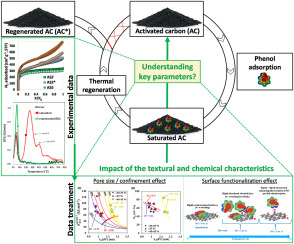Ask for a reprint
email :
* Give your email
2025
ACL
|
F.Olivier, S.Schaefer, K.Maiga, M.Roulet, I.Laidin, C.O.Ania, B.Cagnon, 'Understanding the role of pollutant confinement during the thermal regeneration of activated carbons', Carbon 234 120003 (2025) doi:10.1016/j.carbon.2025.120003
The thermal regeneration of activated carbons is the most commonly used approach to allow their reuse. While the process aims to restore the original porosity of the carbon adsorbent, the thermal treatment very often leads to a drop in textural properties due to the thermal degradation of the pollutants inside the porosity of the carbon adsorbent. Despite being widely reported, understanding of the key parameters of the activated carbons governing the efficiency of the regeneration is yet not well understood. In this study, we have carried out a detailed study on the impact of the textural and chemical characteristics of commercial pristine activated carbons on their regeneration upon several cycles. The activated carbons were saturated with phenol from aqueous solution, and characterized after several cycles of thermal regeneration. Our results show that the confinement state of the adsorbed molecule is important to determine the efficiency of the regeneration. Hence, activated carbons with wide micropores displayed poor regeneration efficiency, due to the occurrence of various adsorbed states in those pores (i.e. dimers, clusters, stacking). Carbons with high oxygen contents also presented low regeneration efficiencies due to specific interactions with the oxygen moieties.
|

|